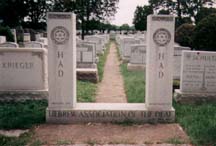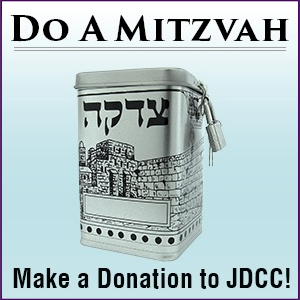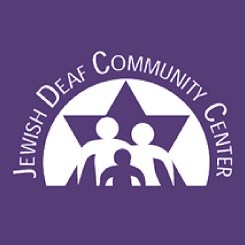
I have been to funerals for family members and friends who passed away. All funerals have different procedures depending on the deceased persons religion and desires. Each religion has its own customs. When my mother passed away recently, I became aware of my friends wanting to pay respect but felt awkward as to what customs and procedures were being used. Several readers suggested that an article be written in JDCC News on these customs and what readers need to be aware of.
Photo: Hebrew Association of the Deaf, New York
Judaism, just like other religions, does have many laws and customs regarding funerals and mourning.
Which Family Members Mourn
Naturally everyone who knew the deceased person is in various degrees of mourning depending on the relationship with the person who passed away. Judaism, however, specifies seven immediate family members who are expected to directly observe the mourning period: the mother and father, son and daughter, brother and sister, (including half-brother and half-sister), and husband and wife.
Clothing And Mourning
These seven certain members of the family in mourning do not wear leather shoes, put on make up or use perfume, shave, take haircuts, or bathe, and no marital relationships take place. All mirrors in the house where the family is sitting Shiva are covered as mourners are not to be vain. All mourners sit on low stools or the floor.
The word Shevah in Hebrew means seven, and the word Shiva is taken from that to mean seven days of mourning following the funeral. More on Shiva will be explained later in this article.
Immediate Burial
The mourning period begins with the funeral. It is tradition for the burial to take place as soon as possible, even on the same day of the death, but no more than two nights after the death. Only under certain circumstances, the burial be delayed. It is considered disrespectful to keep the body from being buried as soon as possible. His soul has returned to G-d, but his body is left to linger in the land of the living. That would be considered a matter of great shame.
Jewish people do not have a wake (where the body is displayed), because Judaism beliefs is that the body should be brought to its resting place as soon as possible. It is not customary to bring flowers because the funeral is to be as simple as possible.
Only wood coffins are used in Jewish funerals because Judaism belief is that we do not preserve the body because as the body decays, the soul ascends to Heaven.
Burial Ceremony Traditions
If you have attended Jewish funerals in the past, you may have noticed one tradition where the Rabbi or a representative tears the blouse or shirt of the seven mourners as a sign of mourning. It is called tearing the Kria. For a mother or father, the left side of the shirt is ripped because it is considered a deeper loss for the parent who brought the deceased into the world and are considered closest to you in feelings. For other family members, the right side of the shirt is torn.
Services starts with the Kaddish, a special prayer which is also recited by a parent for 11 months and by other family members for 30 days. Kaddish is usually said by the son. If there are no sons, family members can designate someone else to say Kaddish for the deceased. It is considered a privilege for the deceased soul to have someone say Kaddish for them.
Regardless of whether you are a Reform, Conservative or Orthodox Jew, many Orthodox beliefs are followed or honored when people want to mourn for a Jewish person in the most traditional way possible. Whenever you are not sure, or are considering a change in rituals, you should consult with your Rabbi, or the Rabbi conducting the service and ceremony.
The Cemetery
Any Jewish person can be buried in a Jewish cemetery. In certain cases, however, if one marries out of the faith or committed suicide, the person would be buried in a separate part of the cemetery.
Cremation is not allowed in Jewish law because the body was given to us as a gift from G-d who expects us to take care of ourselves and return in the best condition possible.
Autopsies are not allowed according to Orthodox law, nor donation of body organs. A Rabbi must be consulted if an autopsy has to be done or an organ donation is being considered. It is acceptable, however, to donate a kidney during the person’s lifetime.
Embalming is not allowed. This process of removing blood, discarding it down the drain and substituting preservative chemicals in the body, is considered desecration of the deceased person and is forbidden by Jewish law.
It is also the Orthodox opinion that the person be buried in the ground. You may have noticed some sites at a Jewish cemetery where the grave looks like a wall. This is not traditional although but under certain circumstances, it can be allowed. A Rabbi should be consulted before a decision is made.
Shiva
During the week of Shiva, any family member and friends come to comfort the mourners, regardless of their religious beliefs. It is customary to bring food, although you may want to check if the mourning family keeps kosher. If they do, then bring either uncut fruit or bakery goods from a kosher bakery or store.
At the first meal after the funeral, mourners eat a hard-boiled egg and something round to indicate that life is like a circle and the mourners have no words to describe their loss.
For thirty days, mourners do not attend weddings, bar/bat-mitzvahs or other events that have music. The son or daughter of the deceased do not attend for 12 months. They also do not shave or cut their hair.
Visiting The Cemetery

Customs vary as to when one may visit the grave site. In Israel, it is customary for people to go on the day they finish sitting Shiva. Others may go at the end of the Shloshim (The Thirty Days), others don’t go for eleven months.
Visitors can bring live flowers although the Orthodox custom, which many other Jewish people also do, is to put stones on the grave instead. Putting a pebble on the grave is an expression of someone having visited to pay respect for the deceased person.
Customs also vary about the Tombstone Unveiling ceremony. In Israel, many people do it after 30 days, other people do it at the 11th month after the burial. The family Rabbi would be the best person to check with.
Follow this link to see examples of tombstone Symbols
Any information can be put on the tombstone. Usual procedure is to place both the English and Hebrew names of the deceased on the tombstone with their fathers name. Some people may also list the birth date and the date that the person passed away. Jewish people who are Cohenim or Leviim also put symbols such as a pair of hands or a wash basin to show that they are a Cohen or a Levi.
Anniversary
We observe the Yarzheit (anniversary date of passing) on the day the person passed away according to the Jewish calendar. During the first year after a parent passes away, one joins in the Yizkor services on the three Festivals and Yom Kippur but does not say the prayer. One of the reasons is because Kaddish is said for the person everyday during the first eleven months. Yizkor in Hebrew means remember.
Yizkor is a prayer said in memory of the person. This prayer is said on Yom Kippur, Shimini Atzeretz, on the last day of Passover, and Shavuot.
Arranging For Burial
There are Jewish funeral organizations such as Chevra Kadisha Mortuaries who can make all the arrangements for burial. They will, for a fee, handle everything from limousine service to and from the funeral, to sympathy acknowledgment cards, obituaries in the local and Jewish newspapers, death certificates, and give out Yarzheit candles (memorial candle for the week of Shiva) to the family.
If the family members belong to a Temple or Synagogue, they can ask their Rabbi to conduct the services. If the members are not affiliated with a Temple and want a specific Rabbi, they need to check if the Rabbi is available and agreeable to conduct the service. Otherwise, the Funeral home can locate a Rabbi to conduct the service.
Pre Planning Needs
This is not a topic that many of us like to talk about. But if we plan in advance just like we do when we need to buy automobile insurance or obtain medical insurance. We hope we will never need the insurance in event of an emergency. It is the same situation when it comes to planning ahead for your burial arrangements. You can choose your preference of site, casket, Rabbi, etc ahead of time and reduce the burden on the loved ones so they don’t have to make all the difficult decisions at once.
The price range for a cemetery plot varies. It is like shopping for a home. You want to know more information about the neighborhood and the average price for a two bedroom home, as one counselor explains, it’s the same for the cemetery. Location is a key factor in the price range. You may want a plot in a specific section, prefer a traditional side by side space, or family estate for semi-privacy within a garden estate for the whole family, wall crypt, or grassy, flat, hilltop, mountain or garden view.
Funeral costs will depend on what kind of caskets. Costs can run between $395 and $7,000 plus tax. Within the price ranges, there are services that are provided such as maintenance of the plot, the tombstone, use of the funeral home for service instead.
Funeral Home
 Larry Goldstein, deaf since birth and a graduate of Gallaudet University, manages all pre-arrangement accounts for his family’s funeral home business in Philadelphia, PA. In his job with Rosenberg’s Raphael-Sacks, Inc., Goldstein also works with members in the Jewish Deaf community and explain their options and how Jewish religious tradition plays a part in choosing a casket.
Larry Goldstein, deaf since birth and a graduate of Gallaudet University, manages all pre-arrangement accounts for his family’s funeral home business in Philadelphia, PA. In his job with Rosenberg’s Raphael-Sacks, Inc., Goldstein also works with members in the Jewish Deaf community and explain their options and how Jewish religious tradition plays a part in choosing a casket.
Helpful Tips for A Checklist
Requesting the death certificate – for legal purposes.
Making arrangements with funeral home – To remove and prepare the body for the funeral.
Get a Rabbi – to provide guidance and spiritual comfort and to make arrangements for the service.
PHOTO: Larry Goldstein
Contact all family members and friends.
Notify Employer.
Inform the deceased person’s affiliations i.e. professional and social organizations.
Notify Insurance agent.
Most importantly you should know where the location is for the wills and vital papers, records, and bank safe deposit box keys and their tallit if the deceased is a male.

Meaning Of Symbols On Tombstones: Blessing hand – Cohen, Pitcher – Levi, Candelabrum and menorah – female, Books – author or leamed man, Star of David – male, Crown and Ark with Torah – Rabbinic Authority

Animals Usually Stand For A Name: Dove – Jonah, Lion – Aryeh, Judah, Leo, Fish – Fischel, Eagle – Adler, Rooster – Hahn, Bear




